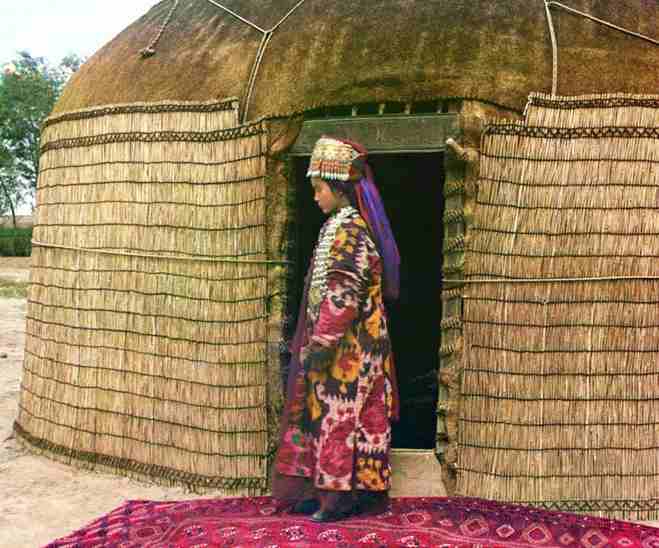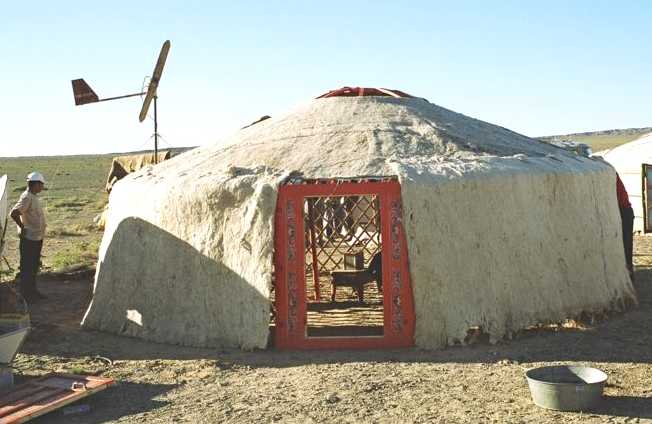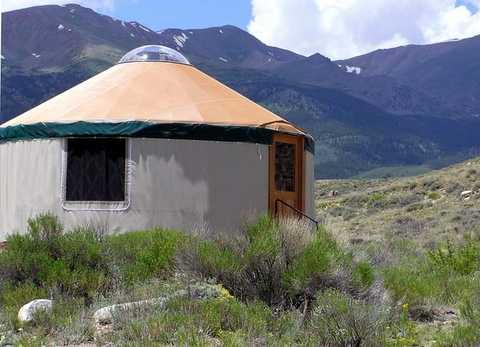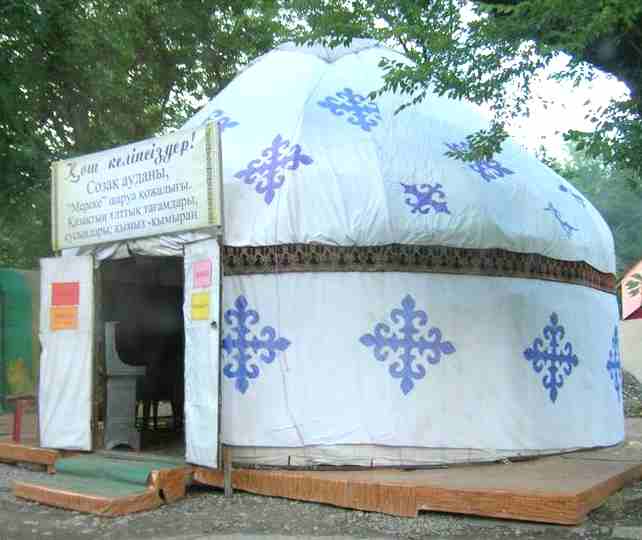|
YURTS
|
|
|
A Yurt is a portable felt dwelling structure used by nomads in the steppes of Central Asia.
Uzbek woman at the entrance to a yurt in Turkestan 1913 picture by Prokudin-Gorskii
Etymology and Synonyms
The word yurt is originally from the Turkic word meaning "dwelling place" in the sense of "homeland"; the term came to be used in reference to the physical tent-like structures only in other languages. In Russian, a yurt is called "yurta" (юрта), and there is an obsolete term "kibitka" (кибитка). From Russian, the word came into English.
In Kazakh the term for the structure is kiyiz üy ("felt home") and in Mongolian it is called a ger (гэр). Afghans and Pakistanis call them "Kherga"/"Jirga" or "ooee". In Pakistan "گہر" Kyrgyz the term is "boizoi", literally "grey house", because of the colour of the felt.
Construction
The yurt consists of a wooden frame, carrying a felt cover. The frame consists of one or more lattice wall-sections, a door-frame, roof poles and a crown. Some yurt-types have one or more columns to support the crown. The (self-supporting) wood frame is covered with pieces of felt. Depending on availability, the felt is additionally covered with canvas and/or sun-covers. The frame is held together with one or more ropes or ribbons. The structure is kept under compression by the weight of the covers, sometimes supplemented by a heavy weight hung from the center of the roof. They vary regionally, with straight or bent roof-poles, different sizes, and relative weight.
Mongolian ger: adding felt cover to wooden frame
Symbolism
The crown itself is emblematic in many Central Asian cultures. In old Kazakh communities, the yurt itself would often be repaired and rebuilt, but the shangrak would remain intact, passed from father to son upon the father's death. A family's length of heritage could be measured by the accumulation of stains on the shangrak from generations of smoke passing through it. A stylized version of the shangrak forms the main image on the flag of Kyrgyzstan. Its cultural iconography is also represented in the tubeteika, a traditional Central Asian skullcap which bears a resemblance to the yurt.
Western Yurts
Enthusiasts in other countries have taken the visual idea of the yurt -- a round, semi-permanent tent -- and have adapted it to their cultural needs. Although those structures may be copied to some extent from the originals found in Central Asia, they have been greatly changed and adapted and are in most cases very different.
In the United States and Canada, yurts are made using hi-tech materials. They are highly engineered and built for extreme weather conditions. In addition, erecting one can take days and they are not intended to be moved often. Often the designs of these North American yurts barely resemble the originals; they are better named yurt derivations, because they are no longer round felt homes that are easy to mount, dismount and transport. North American yurts and yurt derivations were pioneered by William Coperthwaite (founder of the Yurt Foundation) in the 1960s, after he was inspired to build them by an article about Supreme Court Justice William O. Douglas's visit to Mongolia.
In Europe, a closer approximation to the Mongolian and Central Asian yurt is in production in several countries. These tents use local hardwood, and often are adapted for a wetter climate with steeper roof profiles and waterproof canvas. In essence they are yurts, but some lack the felt cover that is present in traditional yurt.
Different groups and individuals use yurts for a variety of purposes, from full-time housing to school rooms. In some provincial parks in Ontario and Manitoba, and state parks in Oregon and Pennsylvania, yurts are available for camping.
Modern Yurt in the Colorado mountains - The Colorado Yurt Company
SPIRITS INTENT - Innovation
Spirits Intent | The Natural Yurt | The Outstanding Yurt | Customise Your Yurt
Spirits Tipis | Pictures | Prices | Spirit Level Design
Contacts:
Lucy Friedlander
LINKS and REFERENCE
Background Information
Yurt Construction
Yurt at the Naadym festival at Tos-Bulak
|
|
|
This website is Copyright © 2013 Kismet Girls Trust. All rights reserved. All other trademarks are hereby acknowledged. |




